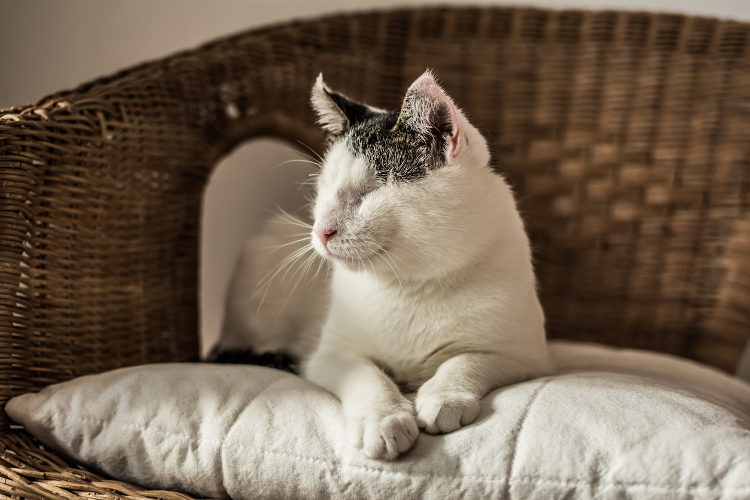Ever loved a disabled kitty? Chances are you have! Many special needs cats have become Internet celebrities, with fans all over the globe. Perhaps the most famous is Lil BUB! Lil BUB was born with several genetic abnormalities – from being a “perma-kitten” with dwarfism to being the only cat with osteopetrosis (a rare bone condition that makes bones denser and harder to move over time). Thanks to receiving so much love from around the world, Lil BUB has gotten amazing care and given back to the community – she and her human founded Lil BUB’s Big FUND to provide grants to shelters helping disabled cats.
If you are considering fostering or adopting a cat with disabilities, you need to know how to care for them. We’ve got you covered.
BLIND OR ONE-EYED CATS
Just because a cat is blind or missing an eye – from birth, accident, or disease – doesn’t make them helpless! Cats have incredible senses besides sight, including their whiskers, hearing, and sense of smell. With the proper precautions and patience, these cats can get along in daily life just fine.
 Image: Nick Ares via flickr
Image: Nick Ares via flickr
Be sure to leave their bowls and your furniture in the same places at all times. Keep the floors clear, and the cat indoors. Engage with them more through their other senses – talk to them often, especially on approach, and give lots of touch-based play and affection. Ideal cat toys would be those that make noise. (If your cat is only partially blind, be sure to always approach on her sighted side.)
There are many blind or partially blind cats out there having the time of their lives – just look at Honey Bee the Blind Hiking Cat who loves exploring the world with her people. Or Oskar the Blind Cat – many visitors to his home don’t realize he’s fully blind!
CATS MISSING LEGS
Sometimes, cats are born or end up missing one or more limbs. Any kitty short a leg or two can still get around and lead a fulfilling life! Again, patience and understanding are key.
 Image: Ridingsilky via flickr
Image: Ridingsilky via flickr
For cats newly missing a limb, they need time to become confident and build muscle tone in their remaining legs. At first, they may require assistance – such as a step – to jump up on furniture or manage the litter box. They might need help staying clean at first. Also, there are prosthetic limbs for pets – talk with your vet about whether your cat is a good candidate.
After a while, though, they’ll be moving around and jumping with ease. Just Google Roux the Bunny Cat, or Mercury, the Tiny T. Rex!
CATS WITH CEREBELLAR HYPOPLASIA
You’ve probably seen cats with CH before, and thought they looked drunk! Cerebellar Hypoplasia means a cat has an underdeveloped cerebellum, often caused by the mother having FPV or the kittens being malnourished before birth. They have jerky movements, tremors, and often fall over.
CH kitties are not in pain. They’re just wobbly. Adopting a cat with CH just means making your home more accessible for the little guy – provide cushioned ramps to furniture like beds or lounging spots. Elevate food and water bowls if it helps, and feed them in a place it’s okay to get messy (in case they fall into the bowl). If they like to get up on windowsills, make sure there’s a soft place for them to land beneath it. Oh, and keep these wobbly kitties indoors!
Check out About CH Cats to learn more.
DEAF CATS
Cats can lose their hearing as they age. Or they might become deaf due to infection or have been born with congenital deafness.
Living with a deaf cat simply requires different forms of communication, like using visual cues such as body language. You also want to be sure not to startle her with a direct touch if she can’t see you. Deaf cats are very attuned to ambient vibrations, so you can use a heavy step when you approach or touch the area around her to get her attention. You can also use treat-training and hand-signals to get her to come when you call. A strict schedule of feeding time and play will encourage her to be where you want her at regular times.
Be sure to keep your deaf cat indoors – they can’t hear traffic or other dangers coming, after all. And check out YouTube, again, for some wonderful videos of people living with deaf kitties.
We hope you’ve learned something about cats with disabilities today, and how they make wonderful and rewarding pets! There are still plenty of physical disabilities we haven’t talked about – from cats with diabetes to those with asthma to older cats with arthritis. Many of these can be managed with variable levels of effort, and if you can manage them, you get the best prize of all: a cat’s love.







